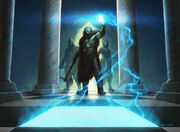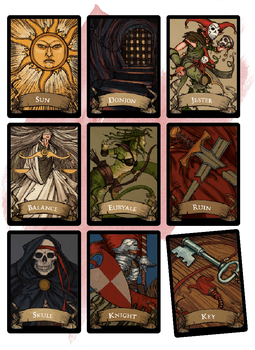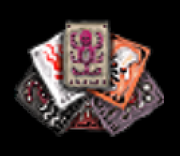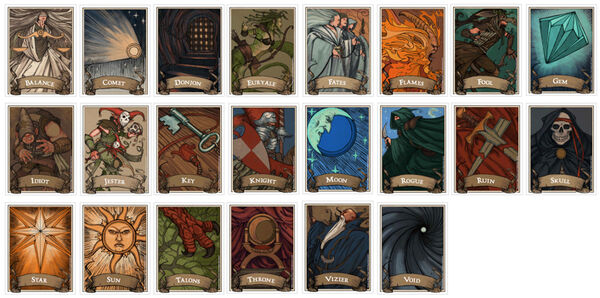A deck of many things, also known as deck of hazards,[1] was an assortment of magical cards or metallic plates that were arranged in a set deck. They were enchanted with great magic that was never to be used lightly.[6][5]
Description
While each deck of many things was different,[6] they held some common properties. The majority of decks found contained 13 cards, while approximately 1/4 of them held 22. They were typically made of vellum or ivory, but could also be cast from thin sheets of metal. They were often kept in a small pouch or ornate box.[5]
The cards were named and each was adorned with a unique portrait[6] that shimmered with a radiance of power. A 13-card deck included the sun, moon, star, throne, key, knight, the void, flames, skull, ruin, euryale, rogue and jester cards, while a 22-card deck added the vizier, comet, the fates, gem, talons, idiot, donjon, balance and fool.[5]
Powers
The exact powers of each individual deck were not known until the cards were drawn.[6] Before this, an individual declared how many cards they intended to draw. They did so randomly and had to wait one hour before drawing again. Any extraneously drawn cards had no effect and if an individual failed to draw the number of cards they'd previously declared, then all the remaining cards flew from the deck and took effect.[5]

A lucky draw from the deck of many things...
Once a card was successfully drawn, its magic immediately took effect and then it faded into oblivion, but instantly reappeared as part of the deck. This made it entirely possible that the same card was drawn more than once. The exception to this rule were the fool and jester cards, which truly disappeared once drawn.[5][7]
Effects
The following effects were known to afflict, benefit, or otherwise change whoever drew the card:
- Sun: They were granted tremendous insight and skill as if they were much more experienced in their travels. In addition, they were granted a single wondrous item from anywhere throughout the Realms or other planes of existence.[8]
- Moon: They gained the ability to cast the powerful spell wish in one to three instances.[6][note 1][8]
- Star: Two defining qualities of them were greatly and permanently enhanced. Such characteristics included their wit, intellect, fortitude, athletic ability, or other similar characteristics that helped define who they were as a person.[8]
- Throne: They became adept at influencing others to a heroic extent. Additionally some random keep located somewhere came into their rightful possession. However, the keep was infested with monstrous creatures that had to be expelled before it could be claimed. There were no recorded instances of any keeps appearing or having their ownership transferred by means of this magic.[8]
- Key: A rare weapon, of a type with which they were proficient, appeared in the hands of the card's drawer.[8][6][note 2]
- Knight: A powerful knight appeared and pledged their loyalty to them. This noble combatant believed that the fates had drawn them to that place and time.[8][6][note 3] This person and the drawer belonged to the same race and sex.[9]
- The Void: Their body was incapacitated and their soul was transported into a random object located somewhere. The location of the object was revealed to anyone nearby. The effects of this card could not be reversed by a wish spell.[8][6][note 4]
- Flames: They earned the enmity of a formidable devil who sought their suffering and destruction. This hatred continued until they or the fiend died.[8][6][note 5] Hostile action by the outsider was taken within one to twenty days of earning the enmity.[10]
- Skull: An avatar of death appeared before them. Before assaulting them with its scythe, the skeletal reaper warned anyone nearby that they were to engage in this fight alone. Anyone slain by the avatar of death could not be resurrected or otherwise brought back to life.[8][6][note 6]
- Ruin: They lost any and all wealth in their possession. While magical items were not affected in this manner, gold and other valuables disappeared. Any businesses, investments, land, or other holdings were also lost along with any corresponding documentation.[8]
- Euryale: The image of the medusa-like creature permanently cursed them. This effect could only be reversed by a deity or the magic of the fates card.[8]
- Rogue: A person became openly hostile towards the drawer of the card although their identity was unknown to them. This hatred could only be alleviated by a deity's intervention or the spell wish.[8][6][note 7] The person who hated the drawer did not make a big show of his or her hatred. Instead, the person hid it until the most opportune time to show it to cause maximum to the object of his or her hatred.[9]
- Jester: Great intuition and expertise were bestowed upon them in a similar manner as if they drew the sun card, albeit to a lesser extent. In addition they could draw two additional cards beyond those that they previously declared.[8][6][note 8]

Nine cards from the 22-card deck of many things
These effects were imbued within the 22-card deck:
- Vizier: Within one year of drawing this card, they could ask a question in a state of meditation and receive an enlightening answer within their mind. Along with specific knowledge, they gained the wisdom to apply that information and if necessary, solve a dilemma or crisis in their life.[8][6][note 9]
- Comet: If they defeated the next hostile creature or group of individuals they encountered single-handedly they gained a great amount of insight from the battle. If this did not occur the card had no effect.[5][6][note 10]
- The fates: They gained the ability to undo the fabric of time and reality, completely erasing one event from their life as if it never happened (including the eurayle's curse). The effects of this card could be used immediately or anytime within their lifetime.[8]
- Gem: A great cache of valuable gems appeared before them, in the form of 25 pieces of jewelry or 50 individual gem stones. The value of these riches totaled 50,000 gp.[8]
- Talons: Every magic item in their possession disintegrated. Any artifacts on their possession were not destroyed in this manner, but did vanish to some other location.[8][6][note 11]
- Idiot: Their intellect and mental faculties were significantly diminished, but not to a point that it could cause death. They could draw one card in addition to those they declared.[8]
- Donjon: They became imprisoned in a state of stasis within an extra-dimensional space somewhere in existence, in a manner similar to the spell imprisonment. All of their clothes, possessions and belongings remained at the location where they drew the card. They remained there until were discovered and recovered,[5] however they could not be located by any divination magic and only by a casting of wish. Even if they previously declared, they drew no more cards.[8]
- Balance: Their alignment was reversed along the axes of both good verses evil and order versus chaos. No effects occurred if they were considered neutral or unaligned.[5][6][note 12] Furthermore, if the drawer's actions did not meet the standards of the newly imposed ethical and moral outlook, the card's magic sapped the drawer's life energy.[7]
- Fool: They lost understanding and competence in a manner opposite to those effects that were caused by the jester card. They drew another card from the deck, regardless of how many other draws they had declared.[8]
History

A set of deck of hazards from Zhentil Keep, circa 1373 DR.
The original decks of many things were created by the ancient Empire of Netheril. Then, these decks were nothing but decks of game cards known as decks of hazards. This casual deck-building game was played with slightly enchanted cards competitively. After the fall of Netheril, the magic contained in surviving decks steeped and swole into the potent cards known across the Realms for their dangers ad possible beneficial effects.[1]
Appendix
| This article is incomplete. Needs 3e information. You can help the Forgotten Realms Wiki by providing more information. |
Further reading
- Randy Maxwell (September/October 1989). “House of Cards”. In Barbara G. Young ed. Dungeon #19 (TSR, Inc.) (19)., pp. 38–58.
Apperances
- Adventures
- Dungeon #19, "House of Cards"
- Video games
- Baldur's Gate II: Throne of Bhaal • Neverwinter Nights series (Neverwinter Nights: Shadows of Undrentide • Neverwinter Nights: Tyrants of the Moonsea)
- Card Games
- AD&D Trading Cards
- Board Games
- Dungeons & Dragons Adventure Begins
External Links
- Deck of Many Things Generator
 Deck of Many Things article at the Baldur's Gate Wiki, a wiki for the Baldur's Gate games.
Deck of Many Things article at the Baldur's Gate Wiki, a wiki for the Baldur's Gate games.
Notes
- ↑ In Baldur's Gate II: Shadows of Amn this card permanently increased their overall heartiness.
- ↑ In BGII: SoA, the weapon was replaced by the Warder's Signet.
- ↑ In BGII: SoA this card summoned four hostile demon knights.
- ↑ In BGII: SoA this card disintegrated the drawer.
- ↑ In BGII:SoA this card summoned an aggressive balor and four hostile fire elementals.
- ↑ In BGII: SoA the avatar of death was replaced by a death shade.
- ↑ In BGII:SoA this card placed them under the effects of dire charm for over 40 days.
- ↑ In BGII: SoA this card was replaced by erinyes that improved all their base attributes.
- ↑ In BGII: SoA this card placed them under the effects of the spell mantle for two hours.
- ↑ In BGII: SoA this card granted permanent protection against fire.
- ↑ In BGII: SoA this card permanently blinded them.
- ↑ In BGII: SoA this card depicted a portrait of the deck's creator. After the portrait smiled at the drawer the deck faded into nothingness.
References
- ↑ 1.0 1.1 1.2 BioWare, Floodgate Entertainment (June 2003). Designed by Brent Knowles, Rick Ernst. Neverwinter Nights: Shadows of Undrentide. Atari.
- ↑ Ossian Studios (August 2019). Designed by Luke Scull. Neverwinter Nights: Tyrants of the Moonsea. Beamdog.
- ↑ Monte Cook, Jonathan Tweet, Skip Williams (July 2003). Dungeon Master's Guide v.3.5. (Wizards of the Coast), pp. 279–281. ISBN 0-7869-2889-1.
- ↑ Rodney Thompson (April 2010). “Deck of Many Things”. In Chris Youngs ed. Dungeon #177 (Wizards of the Coast) (177)., pp. 57–68.
- ↑ 5.0 5.1 5.2 5.3 5.4 5.5 5.6 5.7 5.8 Mike Mearls, Jeremy Crawford, Christopher Perkins, James Wyatt (2014). Dungeon Master's Guide 5th edition. (Wizards of the Coast), p. 162. ISBN 978-0786965622.
- ↑ 6.00 6.01 6.02 6.03 6.04 6.05 6.06 6.07 6.08 6.09 6.10 6.11 6.12 6.13 6.14 6.15 BioWare (September 2000). Designed by James Ohlen, Kevin Martens. Baldur's Gate II: Shadows of Amn. Black Isle Studios.
- ↑ 7.0 7.1 Monte Cook, Jonathan Tweet, Skip Williams (July 2003). Dungeon Master's Guide v.3.5. (Wizards of the Coast), p. 278. ISBN 0-7869-2889-1.
- ↑ 8.00 8.01 8.02 8.03 8.04 8.05 8.06 8.07 8.08 8.09 8.10 8.11 8.12 8.13 8.14 8.15 8.16 8.17 8.18 8.19 Mike Mearls, Jeremy Crawford, Christopher Perkins, James Wyatt (2014). Dungeon Master's Guide 5th edition. (Wizards of the Coast), p. 164. ISBN 978-0786965622.
- ↑ 9.0 9.1 Monte Cook, Jonathan Tweet, Skip Williams (July 2003). Dungeon Master's Guide v.3.5. (Wizards of the Coast), p. 279. ISBN 0-7869-2889-1.
- ↑ Monte Cook, Jonathan Tweet, Skip Williams (July 2003). Dungeon Master's Guide v.3.5. (Wizards of the Coast), pp. 278–279. ISBN 0-7869-2889-1.

